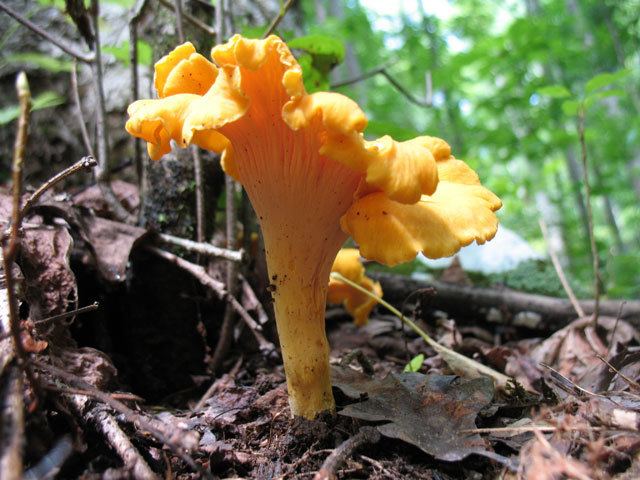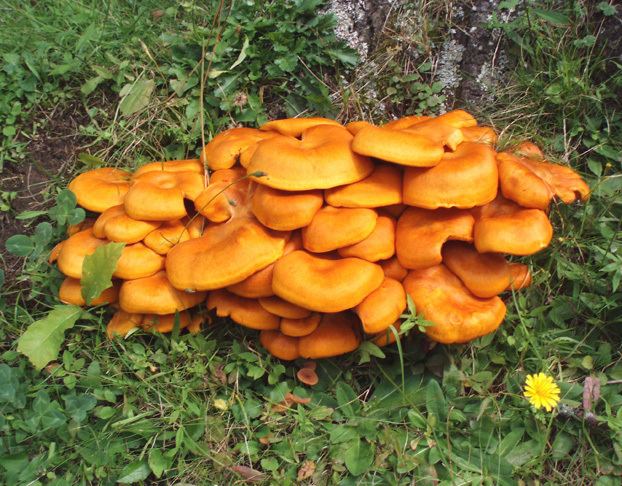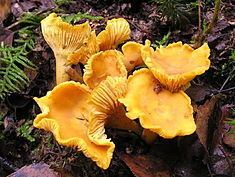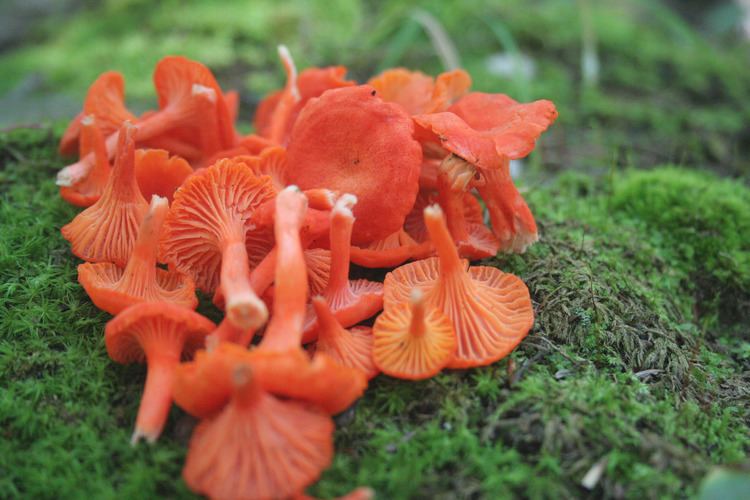Kingdom Fungi Class Agaricomycetes Family Cantharellaceae | Phylum Basidiomycota Order Cantharellales Genus Cantharellus | |
 | ||
Similar True ls, Mushroom, Agaricus, Edible mushroom, Craterellus tubaeformis | ||
Cantharellus cibarius golden chanterelle navadna lisi ka
Cantharellus cibarius, commonly known as the chanterelle, or girolle, is a fungus. It is probably the best known species of the genus Cantharellus, if not the entire family of Cantharellaceae. It is orange or yellow, meaty and funnel-shaped. On the lower surface, underneath the smooth cap, it has gill-like ridges that run almost all the way down its stipe, which tapers down seamlessly from the cap. It emits a fruity aroma, reminiscent of apricots and a mildly peppery taste (hence its German name, Pfifferling) and is considered an excellent edible mushroom.
Contents
- Cantharellus cibarius golden chanterelle navadna lisi ka
- Golden chanterelle canvas
- Distribution
- Biochemistry
- Culinary use
- Similar species
- References

Golden chanterelle canvas
Distribution

Chanterelles are common in northern parts of Europe, North America, Central America, including Mexico, in Asia, including Turkey and the Himalayas (including Kashmir, Nepal, and Bhutan), and in Africa including Zambia, Congo and Uganda. Chanterelles tend to grow in clusters in mossy coniferous forests, but are also often found in mountainous birch forests and among grasses and low-growing herbs. In central Europe, including Ukraine, the golden chanterelle is often found in beech forests among similar species and forms. In the UK, they may be found from July through December.

At one time, all yellow or golden chanterelles in western North America had been classified as C. cibarius. Using DNA analysis, they have since been shown to be a group of related species. In 1997, the Pacific golden chanterelle (C. formosus) and C. cibarius var. roseocanus were identified, followed by C. cascadensis in 2003 and C. californicus in 2008. C. cibarius var. roseocanus occurs in the Pacific Northwest in Sitka spruce forests, as well as Eastern Canada in association with Pinus banksiana.
Biochemistry
Chanterelles are relatively high in vitamin C (0.4 mg/g fresh weight), very high in potassium (about 0.5%, fresh weight), and are among the richest sources of vitamin D known, with ergocalciferol (vitamin D2) as high as 212 IU/100 grams fresh weight. Scientific research has suggested that the golden chanterelle may have potent insecticidal properties that are harmless to humans and yet protect the mushroom body against insects and other potentially harmful organisms.
Culinary use
Though records of chanterelles being eaten date back to the 16th century, they first gained widespread recognition as a culinary delicacy with the spreading influence of French cuisine in the 18th century, where they began appearing in palace kitchens. For many years, they remained notable for being served at the tables of nobility. Nowadays, the usage of chanterelles in the kitchen is common throughout Europe and North America. In 1836, the Swedish mycologist Elias Fries considered the chanterelle "as one of the most important and best edible mushrooms."
Chanterelles as a group are generally described as being rich in flavor, with a distinctive taste and aroma difficult to characterize. Some species have a fruity odor, others a more woody, earthy fragrance, and still others can even be considered spicy. The golden chanterelle is perhaps the most sought-after and flavorful chanterelle, and many chefs consider it on the same short list of gourmet fungi as truffles and morels. It therefore tends to command a high price in both restaurants and specialty stores.
There are many ways to cook chanterelles. Most of the flavorful compounds in chanterelles are fat-soluble, making them good mushrooms to sauté in butter, oil or cream. They also contain smaller amounts of water- and alcohol-soluble flavorings, which lend the mushrooms well to recipes involving wine or other cooking alcohols. Many popular methods of cooking chanterelles include them in sautés, soufflés, cream sauces, and soups. They are not typically eaten raw, as their rich and complex flavor is best released when cooked.
Chanterelles are also well-suited for drying, and tend to maintain their aroma and consistency quite well. Some chefs profess that reconstituted chanterelles are actually superior in flavor to fresh ones, though they lose in texture whatever they gain in flavor by becoming more chewy after being preserved by drying. Dried chanterelles can also be crushed into flour and used in seasoning in soups or sauces. Chanterelles are also suitable for freezing, though older frozen chanterelles can often develop a slightly bitter taste after thawing.
In the Himalayan Kingdom of Bhutan, it is known as Sisi Shamu and is generally picked from the forests. During the season, it is cooked with cheese and chillies or cooked with meat.
Similar species
The false chanterelle (Hygrophoropsis aurantiaca) has a similar appearance and can be confused with the chanterelle. Distinguishing factors are color (the true chanterelle is uniform egg-yellow, while the false chanterelle is more orange in hue and graded, with darker center) and attachment of gills to the stem (the true chanterelle has ridges or wrinkles, which can be quite deep, but not true gills). Though once thought to be hazardous, it is now known that the false chanterelle is edible but not especially tasty, and ingesting it may result in mild gastrointestinal distress. The poisonous species in the genus Omphalotus (the jack-o'-lantern mushrooms) have been misidentified as chanterelles, but can usually be distinguished by their well-developed unforked gills. Species of Omphalotus are not closely related to chanterelles. Other species in the closely related genera Cantharellus and Craterellus may appear similar to the golden chanterelle.
Cantharellus pallens has sometimes been defined as a species in its own right, but it is normally considered to be just a variety (C. cibarius var. pallens). Unlike "true" C. cibarius it yellows and then reddens when touched and has a weaker smell. Eyssartier and Roux classify it as a separate species but say that 90% of the chanterelles sold in French markets are this, not C. cibarius.
Similarly Cantharellus alborufescens, which is very pale, reddens easily, and is found in mediterranean areas, is sometimes distinguished as a separate variety or a separate species.
